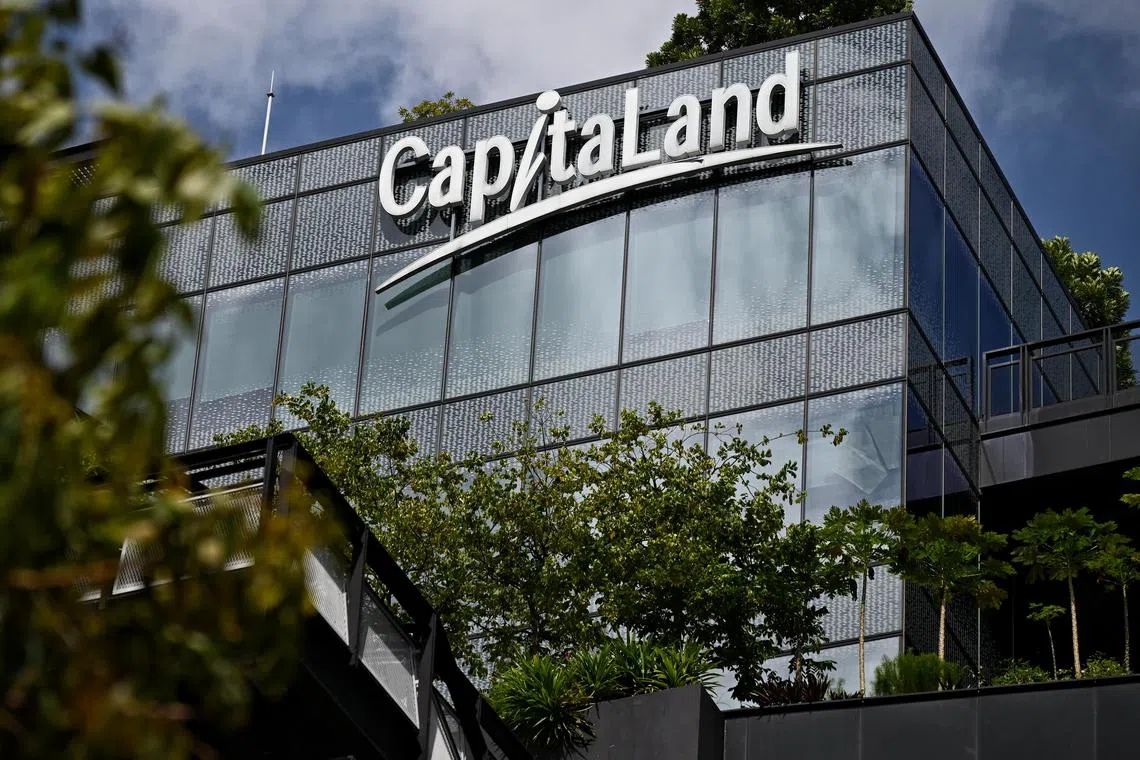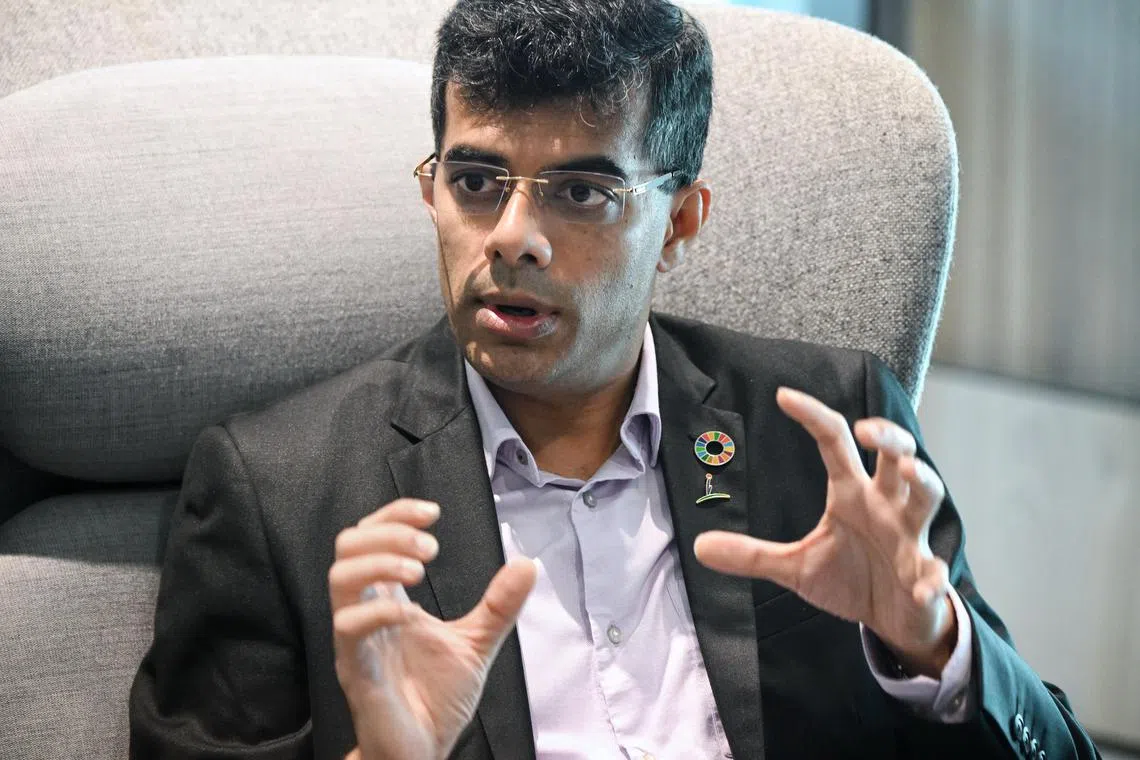CapitaLand Investment pushes ahead with disclosures from suppliers, more green leases
Sign up now: Get ST's newsletters delivered to your inbox

Aside from these initiatives, CapitaLand Investment (CLI) is also exploring new business models to reduce carbon emissions and help with cost optimisation.
PHOTO: ST FILE
Follow topic:
SINGAPORE - Mainboard-listed CapitaLand Investment (CLI) is pushing ahead in its decarbonisation by adding key disclosures from suppliers and ramping up green leases with tenants, even though its efforts to cut carbon emissions did not go as smoothly in 2023 as previously.
These measures are part of the global real asset manager’s plan to reduce Scope 3 carbon emissions.
The emissions are the result of activities from assets that are not owned or controlled by CLI, but indirectly affect the firm’s carbon output.
The firm’s chief sustainability officer, Mr Vinamra Srivastava, told The Straits Times in an exclusive interview that the initiatives are important as Scope 3 emissions make up 68 per cent of CLI’s total greenhouse gas emissions.
Scope 1 accounts for 2 per cent and Scope 2 takes up the remaining 30 per cent of emissions.
The firm has expanded its reporting of Scope 3 emissions.
In its 15th Global Sustainability Report issued recently, the firm included three new Scope 3 categories that are key to its operations. They are: purchased goods and operations, fuel- and energy-related activities, and upstream transportation and distribution.
The firm also widened the scope of the capital goods and downstream leased assets categories after a review.
CLI has been disclosing emissions associated with properties that it does not operationally manage as part of Scope 3 disclosures since 2022.
The latest decarbonisation push becomes more pressing as the firm has less than six years to hit its 2030 goals.
The firm’s Scope 1 and Scope 2 – direct emissions from CLI and emissions that are caused by CLI indirectly through its activities – went up in 2023 by 10.1 per cent against the 2019 baseline.
The rise was led by the 40 per cent growth in CLI’s number of operational properties to 497 in 2023 from 2019, and accounts for the rise in Scope 2 emissions.
Mr Srivastava, who has his work cut out for him, is optimistic.
“If you look at like-to-like same-store basis, which is the properties that were there in 2019 and the same properties that are there today, absolute carbon emissions have gone down by 14.4 per cent.”
He noted that the decarbonisation pathway would never be a linear decline but would be a jagged line in reality.

CLI’s chief sustainability officer Vinamra Srivastava says the focus on Scope 3 emissions is important as they make up 68 per cent of the firm’s total greenhouse gas emissions.
PHOTO: ST FILE
Mr Srivastava said that as long as the assets are energy efficient, the intensity – a key indicator in being green – in the various categories will keep getting lower.
In 2023, CLI’s carbon emissions intensity per sq m dropped 13.2 per cent, energy consumption intensity per sq m fell 13.4 per cent, water consumption intensity was down 24 per cent and waste consumption intensity fell by 44 per cent.
However, CLI’s total electricity consumption from renewable sources in 2023 was 5.2 per cent, lower than the 2030 target of 45 per cent.
Mr Srivastava said: “In many other markets, we are continuing to work to accelerate these green power purchase agreements (PPA). Depending on the market, it’s challenging because in many markets, regulations are not so open yet for corporate PPAs.”
He added that PPAs are often more expensive than normal grid power.
As 2030 approaches, the company would have to assess how it plugs the gap to hit its green goals, either through renewable energy certificates or carbon offsets.
Mr Srivastava said CLI is not using these tools upfront, as the firm wants decarbonisation to be science-based.
In the next six to 12 months, CLI would double down on increasing the number of green leases with its tenants as they contribute about 58 per cent of the firm’s Scope 3 emissions, said Mr Srivastava.
He said the aim is to expand the number and breadth of coverage of green leases beyond Singapore and China.
As at end-2023, the green leases with tenants in China and Singapore grew to 57 per cent, from 43 per cent a year ago.
Mr Srivastava said tenants who are at a more advanced level would have green leases that are stronger. This could be in terms of how legally enforceable the leases would be or how complete the data shared by tenants would be.
Tenants who are just beginning the journey can start with sharing data, for instance.
CLI would also work with its supply chain partners in its bid to lower Scope 3 emissions.
In the past year or so, the firm has categorised the top 400 or so suppliers by how green they are.
Now, CLI wants to create incentive structures in the different categories so that the suppliers, especially those deemed critical, are encouraged to decarbonise, Mr Srivastava said.
“For example, you could create financial products in partnership with banks and with the suppliers, where if they qualify to a certain green level, they could get preferable financing terms from some of our financing partners,” he added.
Given that there would be small and medium-sized companies, the approach CLI would take is a mixture of capability development, training and the incentive structure.
Aside from these initiatives, CLI is also exploring new business models such as cooling-as-a-service in order to reduce carbon emissions and help with cost optimisation.
Instead of having its own air-conditioning and mechanical and electrical systems, CLI could get a third-party provider who can provide these services more efficiently.
As at end-March 2024, CLI had $134 billion of assets under management as well as $100 billion of funds under management held via six listed real estate investment trusts and business trusts, and more than 30 private vehicles across the Asia-Pacific, Europe and the US.


